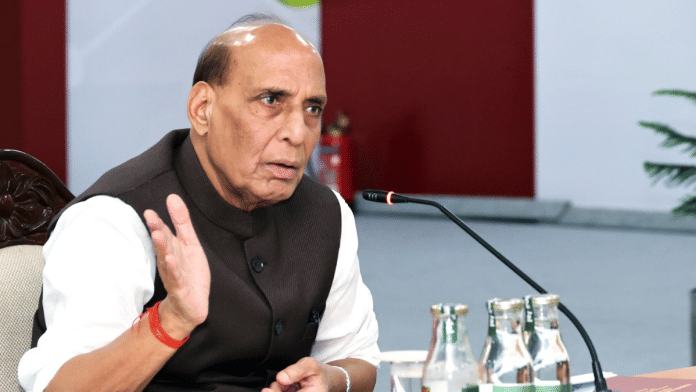New Delhi: Defence Minister Rajnath Singh on Tuesday urged the Armed Forces to strengthen their “surge capacity” and remain prepared for wars he described as increasingly “sudden and unpredictable.”
Addressing the top military brass and senior defence ministry officials at the Combined Commanders’ Conference in Kolkata, Singh stressed how contemporary conflicts can last anywhere from months to years, demanding readiness beyond traditional scenarios.
“Wars of today are so sudden and unpredictable that it is extremely difficult to foretell their duration. It can be two months, a year or even five years. We need to be prepared. We need to ensure that our surge capacity remains sufficient,” he said.
The minister underlined that the Armed Forces must look beyond conventional battlefields and prepare for “invisible challenges” such as disinformation campaigns, ideological subversion, ecological disruptions and biological warfare. These unconventional threats, he said, are now shaping the global security environment as much as the conventional territorial disputes or clashes.
In the same vein, he stressed the need for constant assessment of global turbulence, regional instability and shifting security dynamics, adding that the Armed Forces must adapt to a world where such non-traditional threats are becoming as pressing as conventional ones.
Moreover, he urged the top military leadership to proactively implement Project Sudarshan Chakra by preparing “a realistic action plan.” For this, Singh suggested the commanders devise a medium-term roadmap for the next five years and a long-term strategy for the next decade to bring Modi’s vision to reality.
The system, first announced by the Prime Minister in his Independence Day address last month, is envisioned to be along the lines of Israel’s Iron Dome or the US-proposed Golden Dome, with the air defence system expected to be rolled out within the next ten years.
Further, picking up on Prime Minister Modi’s call for ‘JAI’ (Jointness, Aatmanirbharta (self-reliance) and Innovation), Singh also pressed for closer coordination between the Army, Navy and Air Force.
The push for greater integration comes at a time when clear dissonance has emerged among the three services on the concept of theatre commands.
Army Chief General Upendra Dwivedi and Navy Chief Admiral Dinesh K. Tripathi have both spoken in favour, describing theaterisation as “inevitable” for future jointness. Meanwhile, IAF Air Chief Marshal A.P. Singh has argued that a centralised joint command in the national capital would be more effective than dividing air assets among multiple theatres.
The minister also mentioned the approval of the Defence Procurement Manual 2025, which aims to streamline the defence ministry’s revenue procurements and ease private sector participation.
In parallel, the Defence Acquisition Procedure 2020, which governs larger capital purchases, he said, is being revised to cut delays and accelerate the delivery of equipment to the forces. ThePrint had reported in March that the ministry had approved a proposal to nearly halve procurement timelines, an initiative expected to feature in the updated DAP later this year. Other changes under consideration back then included removing outdated practices, such as product reservation for defence PSUs and streamlining procedural bottlenecks that have historically slowed down defence acquisitions.
In his address, the defence minister also commended the Armed Forces for Operation Sindoor, which he said demonstrated that strength, strategy and self-reliance form the three pillars of India’s 21st-century military capability.
“Today, we have the capability to face any challenge with the help of indigenous platforms and systems coupled with the indomitable courage of our soldiers. This is the real strength of Aatmanirbhar Bharat,” he said, praising the forces for their “outstanding performance” and “exemplary professionalism.”
(Edited by Vidhi Bhutra)
Also read: Operation Sindoor model will not work in future wars. India must not delay theaterisation






